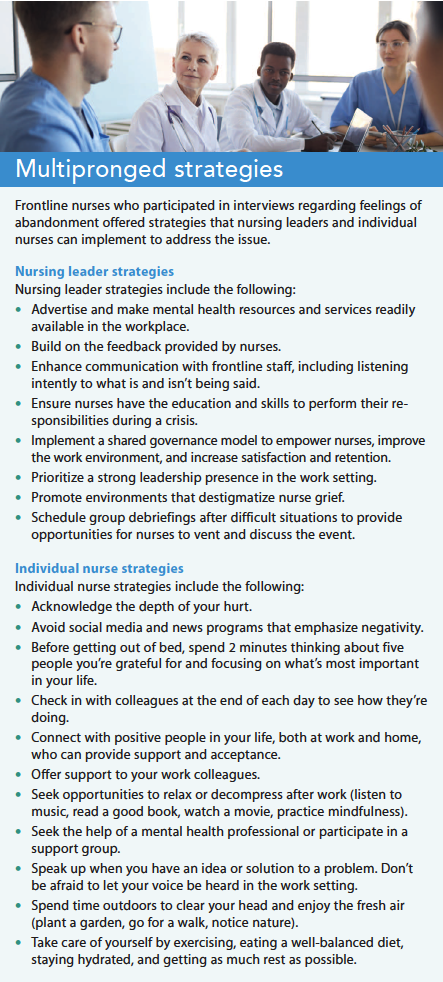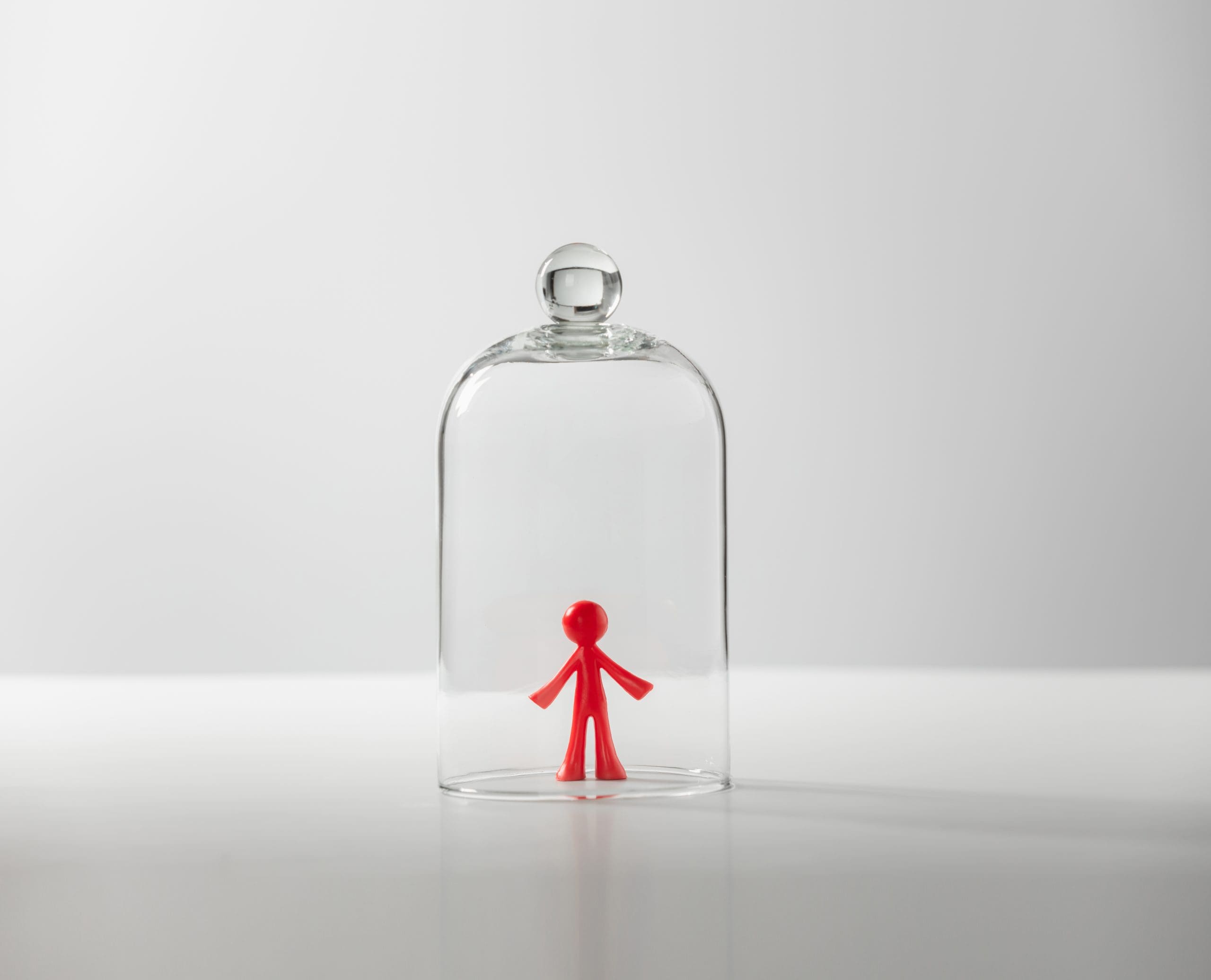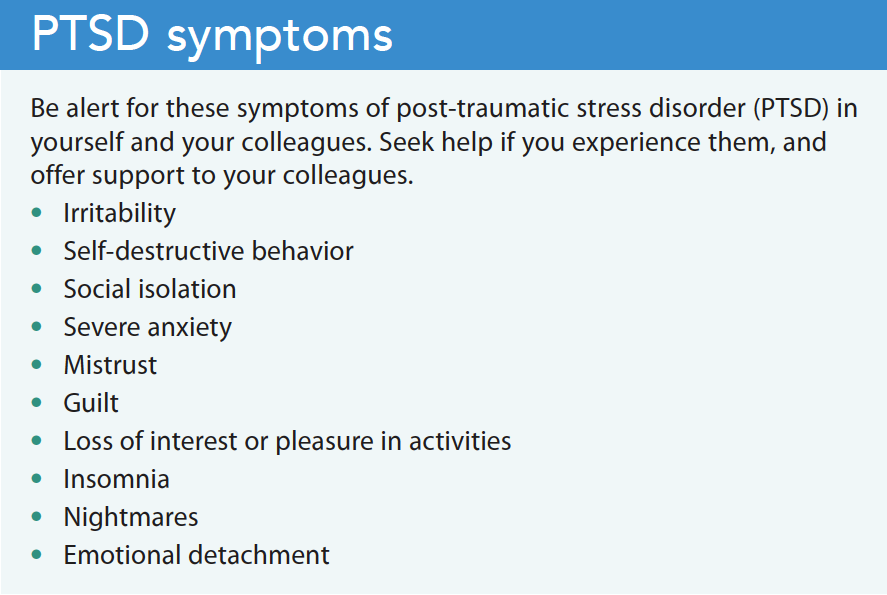Nurses need evidence-based support strategies.
- During the COVID-19 pandemic, rural nurses experienced feelings of abandonment at work as well as within their own families and communities.
- Experiences of frontline nurses during the pandemic resembled warlike settings.
- Strategies for addressing feelings of abandonment require nurses and nursing leaders to foster lines of communication and promote safety and wellness at work.
To date, approximately 6.3 million people worldwide have died as a result of COVID-19. As the number of deaths increased, frontline nurses courageously battled the disease, frequently at a cost to their personal wellness. This battle began to draw close similarities to war as nurses engaged against an enemy they weren’t prepared for; COVID-19 had come to their hometown and they were fighting on the frontlines.
Parallels to military experience
The frontline of the healthcare crisis during the COVID-19 pandemic began to resemble a warlike setting. Nurses described their unit environment as similar to a battlefield. “Our unit looked like a war zone.” These similarities expanded beyond the workplace environment and into their communities, much like what military veterans experienced when they arrived home from war.
Many military troops reported feelings of abandonment and ostracism during the Vietnam War. One soldier said, after receiving the Purple Heart, “Back home this medal won’t even buy me a cup of coffee.” Some theories suggested that these veterans returned home to communities that were frightened, uncomfortable, and lacked understanding of what the veteran had experienced in combat. Egendorf spoke with Vietnam veterans who described “feeling alone, misunderstood, ignored, or insufficiently appreciated.” Frontline nurses have expressed similar feelings.
Many soldiers expressed the sentiment that “only a veteran can understand.” In other words, no one can fully grasp an experience unless they personally participated in it. Similarly, nurses have had difficulty relating to people outside of the healthcare system who weren’t battling on the pandemic frontline. At the height of the pandemic, when they could turn only to each other, nurses lacked connection with the family and community networks they typically relied on for support. This inability to make connections left nurses feeling isolated and contributed to the perception of abandonment.
Uncovering nurses’ experiences
During the pandemic, Robinson and colleagues conducted interviews with 19 frontline nurses working in intensive care and COVID-19 medical units of three tertiary hospitals in the upper Midwest. This qualitative phenomenological study aimed to understand nurses’ experiences caring for patients with COVID-19 and how they balanced the demands of work and home life. The audiotaped face-to-face interviews took place between January and June 2021. Three experienced doctoral-prepared nurse analysts interpreted the transcribed interview data separately and together, using approved qualitative methods specific to transcendental phenomenology. They came to consensus on four themes related to frontline nurses’ quotes: overwhelmed, frustrated, abandoned, and perseverance to resilience.
These nurses, who live and work in two of the least densely populated rural states, were overwhelmed by the high volume of critically ill patients and frustrated by the chaos in the care environment. They expected these feelings while battling the unknown COVID-19 enemy. What surprised them was their feeling of abandonment at work as well as by their own families and communities. How did that happen? We went from displaying “Nurses are heroes” signs early in the pandemic to nurses expressing feeling abandoned by their leaders, families, and communities.
Abandonment experienced by frontline nurses
Early in the pandemic, a false sense of security occurred. Many North and South Dakotans believed their states would be spared the worst of the pandemic, so, throwing caution to the wind, communities disregarded public health recommendations such as social distancing and mask wearing. Residents continued to socialize at grocery stores, churches, and bars. An annual motorcycle rally went on as scheduled, drawing an estimated 460,000 people. By early fall of 2020, North Dakota had the highest per capita COVID-19 death rate in the world. It was in this context that nurses worked countless hours at the bedside to care for patients with COVID-19. The quotes below describe the lived experience of nurses who felt abandoned while battling the pandemic.
Work environment abandonment
Working in a practice environment with rapid protocol changes and unfamiliarity with equipment and procedures, nurses felt abandoned in their work setting in the midst of caring for massive volumes of critically ill patients. Some managers, who nurses relied on for support and guidance, left and were replaced by individuals who weren’t visible and provided conflicting messages.
One nurse stated, “It just felt like we were forgotten about in the COVID world where no one wanted to come and see us. We didn’t have a manager to bring our issues to. So, we just felt left out and fending for ourselves.” Needing assistance in a chaotic environment, nurses asked themselves, “Who do I call for help?” Some of the most experienced nurses left at the beginning of the pandemic, leaving behind new nurses “here for a year, a year and a half” to take their place. “That’s still a baby nurse for ICU.” Nurses described feeling left behind, discarded, and not having a voice.
Family abandonment
Some nurses expressed a sense of abandonment within their own families due to a lack of understanding of their experience with suffering and death. They described situations in which some family members had different beliefs, saying, for example, “This is a hoax. This is a way for the government to control us. It’s not that bad.” Some families would tell the frontline nurses, “…the doctors are lying to you. They’re just trying to get your money for COVID.” Many nurses reported that they would “go home and try to talk to family and nobody got it,” so, out of frustration, they just stopped talking about their experiences to some family members.
Several frontline nurses looked forward to spending Thanksgiving in their rural hometown, only to be told by family that it would be better if they stayed away out of concern that they might bring COVID-19 to the group. One nurse described looking forward to spending time with a friend. The event was cancelled because the friend’s family feared the nurse might have COVID-19. “I just felt like, in some ways, a leper,” she said.
This attitude displayed by family members and friends wasn’t unusual. In Taylor and colleagues’ online survey of non-healthcare worker adults in the United States and Canada, more than a third of respondents said they avoided healthcare workers during the pandemic out of fear of infection. Over 25% felt that healthcare workers should have “severe restrictions” placed on their freedoms, including isolating them from families, friends, and communities.
Community abandonment
Working long hours trying to save lives only to experience more deaths in one day than they ever had prior to the pandemic left nurses physically and emotionally drained. Then they went home and listened to the news or scrolled through social media to hear the public’s disbelief about the disease and its consequences and that members of their communities weren’t taking necessary precautions to reduce the virus spread. Many nurses asked, “If we’re the most trusted profession, why don’t they believe us?” Adding salt to an already open wound, nurses noted that, “NFL players were getting tested every day,” while in the nurses’ communities and healthcare organizations, few people received testing and guidelines lacked clarity. “It was just like a huge slap in the face.”
Nurses residing with or regularly visiting family in rural communities expressed profound concern about the views and practices of their families and neighbors. One nurse said, “I’m from a super small town. So, there’s a lot of people that are pretty conservative and just don’t feel like they want to be restricted.” Another said, “I feel safer at work than I do going to the grocery store or church. No one is wearing masks.”
These experiences proved difficult because of the interconnectedness among nurses and their patients, families, and rural communities. The feeling of abandonment intensified when nurses cared for patients who they knew had been opposed to masking, social distancing, and vaccinations before being diagnosed with COVID-19.
Professional and patient care implications
When psychological distress and emotional stressors aren’t recognized and addressed promptly, individuals become vulnerable to developing post-traumatic stress disorder (PTSD). During the COVID-19 pandemic, rural American frontline nurses repeatedly experienced traumatic stressors, including feelings of abandonment, which can result in PTSD and negatively impact nurses’ ability to provide effective patient care. Lack of social interaction and support is an important determinant of distress after traumatic events. Military PTSD research reinforces the value of a strong support system throughout one’s work experience as well as access to effective mental health services after a stressful event. (See PTSD symptoms.)
As nurses experience the long-term effects of abandonment, many may take the advice offered by some North and South Dakota nurses, “You have to decide what you can deal with and that you are doing great work. But if it’s too much, then you have to just step back because it will ruin you and it will bring you down.” Leaving a profession already facing an increasing need and a decreasing supply of hospital nurses has key implications for the healthcare community, and more importantly, to the quality of patient care.
On a recent podcast, Peter Buerhaus, PhD, RN, FAAN, estimated that the United States will need one million RNs by 2030; however, this need may increase if younger and middle-aged nurses leave the profession because of the emotional stress they experienced during the pandemic. In addition, those contemplating a nursing career may note what nurses are currently experiencing and have a change of heart. These factors can lead to decreased enrollment in nursing education programs and fewer new graduate nurses entering the workforce, which will directly impact patient outcomes, including longer lengths of stay, decreased patient satisfaction, and increased risk of medical errors.
Addressing abandonment in future events
Addressing the multifaceted feelings of abandonment experienced by nurses during the pandemic requires multiple strategies. The responsibility can’t lie solely with the nurse to improve their wellness with self-care. Although self-care continues to play an important role, it’s no longer sufficient on its own. We must recognize the profound impact individuals, communities, and work cultures have on nurses’ wellness. Support from these entities promotes resilience and nurses’ ability to overcome adversity. Nurses require strategies that promote psychological health and safety and physical wellbeing so they can meet these same needs in patients. Nurses can’t give what they aren’t receiving.


Protect frontline nurses
Families, workplaces, and communities play a significant role in fostering wellness for anyone exposed to traumatic events. Nurse leaders must act to combat feelings of abandonment experienced by nurses during the pandemic and prepare to protect them in future events. Promoting psychological safety by improving communication and providing necessary support will directly impact the psychological and physical wellbeing of nurses who serve on the frontlines of healthcare.
Karen R. Robinson is a nursing research consultant at Sanford Health in Fargo, North Dakota. Michelle Gierach is an associate professor at Augustana University in Sioux Falls, South Dakota. Samantha Bartelt is a nursing practice specialist at Sanford Health in Fargo. Brenda Wolles is a clinical educator at Sanford Health in Sioux Falls. Coreen McClellan is a clinical nurse at Sanford Health in Bismarck, North Dakota. Janel Hodge is a clinical nurse at Sanford Health in Fargo. Jennifer Lovro is a senior clinical nurse specialist at Sanford Health in Sioux Falls.
Key words: abandonment, frontline nurses, COVID-19, military veterans
American Nurse Journal. 2023; 18(3). Doi: 10.51256/ANJ032312
References
Ayotte BJ, Schierberl Scherr AE, Kellogg MB. PTSD symptoms and functional impairment among nurses treating COVID-19 patients. SAGE Open Nurs. 2022;8:2377960
8221074651. doi:10.1177/23779608221074651
Chaffin J. “It’s finally got to rural America:” Coronavirus surges in the Dakotas. Financial Times. 2020. ft.com/content/82311cae-7775-4359-9c47-c13ea1e4bee7
Creswell JW, Poth CN. Qualitative Inquiry and Research Design: Choosing Among Five Approaches. 4th ed. Thousand Oaks, CA: Sage Publications; 2017.
Egendorf A. Vietnam veteran rap groups and themes of postwar life. J Soc Issues. 1975;31(4):111-24. doi:10.1111/j.1540-4560.1975.tb01015.x
Gibbons SW, Hickling EJ, Watts DD. Combat stressors and post-traumatic stress in deployed military healthcare professionals: An integrative review. J Adv Nurs. 2012;
68(1):3-21. doi:10.1111/j.1365-2648.2011.05708.x
Gordon JM, Magbee T, Yoder LH. The experiences of critical care nurses caring for patients with COVID-19 during the 2020 pandemic: A qualitative study. Appl Nurs Res. 2021;59:151418. doi:10.1016/j.apnr.2021.151418
Hospitals in Focus with Chip Kahn. No silver bullet: Diagnosing our hospital workforce crisis with Peter Buerhaus. Federation of American Hospitals. February 9, 2022. fah.org/podcasts/no-silver-bullet-diagnosing-hospital-workforce-crisis-with-peter-buerhaus/
Kaye-Kauderer H, Feingold JH, Feder A, Southwick S, Charney D. Resilience in the age of COVID-19. BJPsych Adv. 2021;27(3):166-78. doi:10.1192/bja.2021.5
Kellogg MB, Schierberl Scherr AE, Ayotte BJ. “All of this was awful:” Exploring the experience of nurses caring for patients with COVID-19 in the United States. Nurs Forum. 2021;56(4):869-77. doi:10.1111/nuf.12633
Robinson KR, Jensen GA, Gierach M, et al. The lived experience of frontline nurses: COVID-19 in rural America. Nurs Forum. 2022;57(4):640-9. doi:10.1111/nuf.12727
Taylor S, Landry CA, Rachor GS, Paluszek MM, Asmundson GJG. Fear and avoidance of healthcare workers: An important under-recognized form of stigmatization during the COVID-19 pandemic. J Anxiety Disord. 2020;75:102289. doi:10.101016/j.janxdis.2020.102289



















